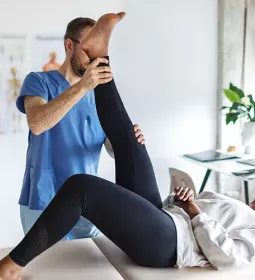My dad believes that stretching and exercising are the same thing. Not because he is aging and showing signs of dementia. He believes this because he is stubbornly strong and grew up in a time when stretching was not only not practiced, it wasn’t emphasized as an important part of soft-tissue health. This has created some confusion in our long-distance phone calls about what he is doing for his bad back.
He was given a routine of exercises and stretches by his physical therapist and was doing them determinedly. But he wasn’t getting better—at least not at the rate he wanted to. Not only is he stubborn, he’s also impatient. So, I agreed to watch what he was doing and offer some insights to see if I could help.

Within a few minutes, it was clear to me that he was powering through his stretches in a way that made it evident he wasn’t actually stretching. He was “exer-stretching.” He was pushing through his stretches like he was competing in a race. This competitive spirit was deeply embedded into every cell of his being. So I couldn’t blame him. But I needed to figure out how to redirect him.
I found a bridge in pandiculation. Even if you are unfamiliar with this term, I have no doubt you know what it is. It is sometimes referred to as “yawn stretching.” In the words of Olivier Walusinski, “Pandiculation is the involuntary stretching of the soft tissues, which occurs in most animal species and is associated with transitions between cyclic biological behaviors, especially the sleep-wake rhythm.”1 In other words, this is that innate need to stretch, engage, and take in a lot of air, all at the same time, often when you wake up in the morning.
When it comes to stretching, this type is my favorite. As you probably already know, there are many types, but it is not always clear which is which. Understandably, there is some crossover. And like my dad, there are those who believe that they are stretching when they are actually powering though a stretch so aggressively that it defeats the purpose.
The reality, though, is that there are three categories under which most stretches fall: static, dynamic, and precontraction stretching. These are sometimes called different things depending on who is talking. But the general overview tends to be the same.
Static stretching is the most common. This is when a position of length is held for a determined amount of time. It can be done actively (e.g., a client brings themselves into the stretch) or passively (e.g., someone, an awesome massage therapist like you perhaps, brings a client into the stretch). Its goal is to lengthen and relax the tissues.
When it comes to stretching, pandiculation is my favorite. This is that innate need to stretch, engage, and take in a lot of air, all at the same time when you wake up in the morning.
Dynamic stretching is what you might see an athlete do before a competition. It is sometimes called active stretching (not to be confused with active static stretching) or ballistic stretching, and it involves waking up a region by bringing it through its range of motion rapidly by bouncing or swinging. Think Olympic swimmer Michael Phelps windmilling his arms before a 200-meter freestyle swim.
Finally, precontraction stretching is an umbrella term for subcategories like PNF (proprioceptive neuromuscular facilitation), CR (contract relax), PIR (post-isometric relaxation), MET (muscle energy technique), and all the other acronyms that have a client contracting a muscle before a stretch in efforts to accentuate said stretch. This is a handy-dandy tool, and I highly suggest you read up on this if it’s not already in your bag of tricks.
All of these do better when combined with breath—the focused, present, deep inhales and exhales that invite the parasympathetic nervous system to chime in and get the soft-tissue system to ease up. Because much of the time, we stretch to calm ourselves down.
So where does pandiculation fall? Think about that early morning stretch. It is kind of static but kind of dynamic. It is kind of elongating but also kind of engaging. It is definitely a combination of flexing muscles while stretching soft tissue while holding an inhale at the top of the breath—all in one big movement.
This innate connection to the animal kingdom happens the moment we are born, and we do it subconsciously and almost daily throughout our lives. Ultimately, it serves a real purpose. This kind of stretching is not about creating length or getting more flexibility. It’s about waking up the entire musculoskeletal system—the muscles, fascia, connective tissue, and interweaving blood and nerve vessels that keep these tissues healthy. (And it feels amazing.)
Pandiculation has its own lane in the world of soft-tissue health. It is not (yet) taught in massage school or physical therapy programs. Nor is it something we ask our clients to do as a modality. Yet it’s this coming together of exercising and stretching, movement and stillness, and expanding and contracting that gives us the incredible benefits of launching movement and blood flow for the day.
As for my dad, I introduced him to the concept of pandiculation and explained that if he could envision separating the engaging-and-holding-the-breath part from the stretching-and-lengthening part, he might be able to differentiate exercises from the kinds of stretches his PT was asking him to perform. This seemed to help. He mustered up a couple of movements that didn’t incite his need to compete. And I could have sworn I saw a little light bulb appear over his head.
Note
1. Olivier Walusinski, “Yawning: Unsuspected Avenue for a Better Understanding of Arousal and Interoception,” Medical Hypotheses 67, no. 1 (March 2006): 6–14, http://doi.org/10.1016/j.mehy.2006.01.020.








